Diesel engines have practically disappeared from the passenger car market – in part because of regulatory compliance costs that have hurt their cost-to-benefit ratio. They’re more expensive to manufacturer; and they’re not as fuel-efficient as they used to be.
Diesel fuel also costs about 30 cents more per gallon than regular unleaded – also because of regulatory compliance costs.
All of these factors have eroded the economic case for diesel engines in cars.
But they’re making a big comeback in the light truck department, where other considerations – such as towing grunt and being able to drive without stopping to refuel for a long time are desirable attributes, regardless of the price of fuel.
Chevy is the latest to ante up – or rather, catch up.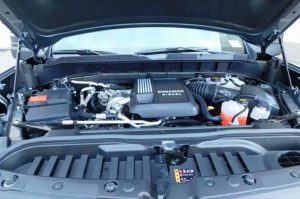
Ford and Dodge (Ram) already offer diesel engines in their half-ton trucks, the F-150 and Ram 1500.
And now the Chevy Silverado does, too.
What It Is
The Silverado, like the F-150 and Ram 1500 (and the Nissan Titan and Toyota Tundra) is a full-size truck available in regular, crew and double cab configurations – and with three different bed lengths and in several dozen different trim/package combinations.
Prices start at $28,300 for a base 2WD regular cab Work Truck with an eight foot foot bed and a 4.3 liter gas V6, paired with a six-speed automatic. This truck isn’t a stripper with metal floors and no gauges.
It comes standard with AC, a six-speaker stereo with AppleCarPlay, Android Auto and 7-inch touchscreen.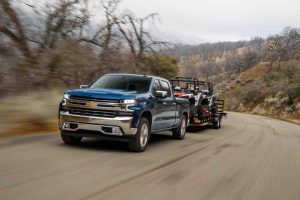
A top-of-the-line High Country 4×4 crew cab with a 6.2 V8 and a ten-speed automatic stickers for $59,295. This one comes with a powered tailgate – up and down – heaters (and leather) for all the seats, deploying and retracting running boards, an upgraded 8-inch touchscreen, 4G in-vehicle WiFi and a 20 inch wheel/tire package.
In between are Custom, LT, RST (on-road sport) and Trail Boss (off road) trims, the latter with a factory-installed two inch lift kit.
And the really big news:
A 3.0 liter turbo-diesel six is now available optionally as part of a bundled package that includes a heavy-duty six-speed automatic transmission calibrated for the diesel, high-output alternator and battery, heavy-duty cooling, an engine block heater and a 3.23 axle ratio.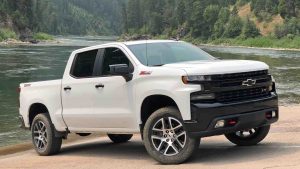
The price varies from $2,495-$3,890 – depending on which trim you start out with.
What’s New
In addition to the diesel engine, the ’20 Silverado is also available with adaptive cruise control and an updated trailer-towing system that transmits 15 different close-circuit camera images to the LCD display inside the truck.
Extensive use of aluminum for exterior body panels (hood, doors, tailgate) has reduced the Silverado’s curb weight by more than 400 pounds.
Chevy buyers no longer have to buy a Ford or a Ram to get a diesel.
Most powerful diesel in the class.
Highest highway mileage in the class.
Lane Keep Assist and other driver “assists” are still optional.
Diesel engine isn’t available with the regular cab/Work Truck Silverado. You have to buy a four-door (extended or crew cab) Silverado and then a more expensive LT or higher trim before you can buy the diesel engine.
Lowest tow rating (9,300 lbs.) in the class.
Dumpster face.
Aluminum panels shave weight but are easier to hurt – and more expensive to fix – than steel.
The Silverado offers the widest range of engines in the class. Five of them – ranging from a turbocharged 2.7 liter four cylinder – the only four cylinder engine in the class – to the biggest V8 in the class – a 6.2 liter, 420 horsepower asphalt-ripper borrowed from the current Corvette that can get this full-sized pick-up to 60 on the heels of a Corvette.
In between are the standard 4.3 liter gas V6 without a turbo, a mid-sized 5.3 liter V8 and the new-for-2020 3.0 liter diesel six with a turbo.
The 4.3 V6, which Chevy has been making forever and has a established track record as a reliable workhouse, is now a powerhouse. It makes 285 hp and 305 ft.-lbs. of torque.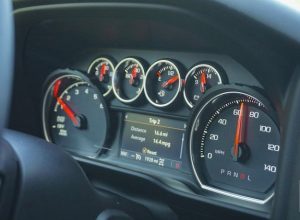
Back in 2000, the 4.3 V6 made 200 horsepower – just for the record.
This engine can be paired with 4WD – but Chevy really sticks it you. The price jumps from $28,300 for the 2WD version to $32,900 for the same truck with 4WD.
That’s what you call an upsell – especially since a truck without 4WD is like a cheeseburger without the cheese. At least McDonald’s doesn’t ask for $4 extra for the slice. Still, the 4.3 V6 is one of the best truck engines around. It’s not an overhead cam engine and it’s not a car engine. It shares its origins with Chevy’s long-serving family of small block V8s, which have been running reliably since the late 1950s in millions of Chevy vehicles. It’s just a shame that Chevy won’t sell you one with 4WD for $30k or less.
The next-up engine is a controversial engine. It is the 2.7 liter four cylinder engine, which seems an odd engine to put into a full-size truck. No one else does, at any rate.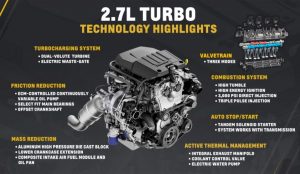
So why did Chevy?
For the sake of “better gas mileage.” Which might be a sell if the mileage was a lot better – and the price were lower.
But they’re not.
The V6/2WD Silverado manages 16 city, 21 – reasonable mileage for a big truck; it’s actually about the same mileage you’d get out of a full-size minivan.
With the turbo’d four (and an eight-speed automatic) the figure rises – feebly- to 20 city, 23 highway. Which feeble gain is washed away by the much higher cost of the Silverado equipped with this engine. And the likelihood or at least potential of much higher repair costs when something expensive hanging off this hugely complicated little engine sticks it blued tongue out at some point down the road. 
Chevy won’t even sell you this engine in the regular cab/Work Truck version; the only optional engine available with that combo is the mid-range 5.3 V8 (355 hp and 383 ft.-lbs. of torque) which you can buy for a much more reasonable $1,395 extra.
The four – which only makes 310 hp and 348 ft.-lbs. of torque – requires stepping up to the double cabs, which start at $32,200 for a 2WD model. Adding 4WD boosts the MSRP to $35,500.
At the pinnacle, there’s the 6.2 V8, which is also limited in availability to the four-door versions (double and crew) and to the LTZ and High Country trims.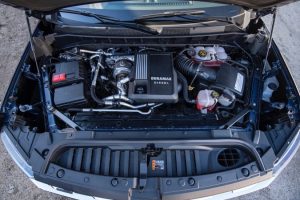
The new 3.0 liter diesel produces 277 hp and 460 ft.-lbs. of torque – the power of a much larger gas V8 with a much smaller appetite.
Its 33 MPG capability (2WD versions) beats that of the much less powerful base 4.3 liter gas V6 by an impressive 13 MPG . . . while almost doubling its tow rating to 9,300 lbs.
Weirdly, though, the less powerful Ram 1500 and Ford F-150 diesels – 260 and 250 horsepower, respectively – are rated to pull more.
The Ford can handle 11,500 lbs. and the Ram 12,560 lbs.
There used to be a fair amount of difference between trucks – and between trucks and cars.
Some trucks rode – and handled – noticeably better (or worse) than others. And all trucks handled oafishly compared with cars.
That changed when people began driving trucks instead of cars. Which they began to do in the late ’80s, as the effects of government regulations began to felt in the design of new cars, which got much smaller and felt flimsier – which they were. They also shifted over to a front-wheel-drive layout, which was better for economy but terrible for ruggedness. You could hang a 5,000 lb. trailer on the bumper of a full-frame Olds Vista Cruiser with a Rocket 455 V8 up front and a cast iron axle out back – and not risk leaving something behind.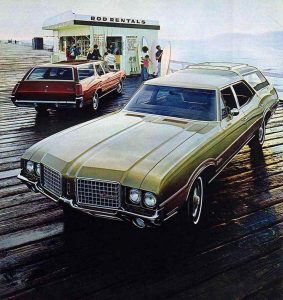
You couldn’t do that with a FWD K-car sportin a 2.4 liter “Hemi” mounted sideways up front.
So people shifted over to trucks (their enclosed-bed brethren, SUVs). And these were carpeted and sound-deadened and re-engineered to be easy for a sixteen-year-old girl to learn to drive in while also being able to do the work people still expected of trucks.
Today’s trucks ride better than most cars – having (like the big sedans and wagons of the past) the benefit of body-on-frame construction with rubber biscuits sandwiched in between, dissipating road shock before it penetrates the cabin space – and they handle almost as well. Their main limitation being they’re so huge that some of them is still entering the curve as the first part is leaving it.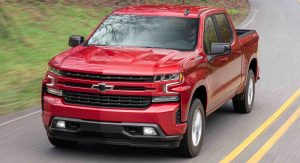
That’s the main thing to know about the Silverado – and the others. They are as easy to drive as a Civic. Light, precise steering. No road/tire drone. On the open road, they are wonderful. You will feel like Leonardo DiCaprio’s character on the fo’c’sle of Titanic:
I’m the king of the world!
The only icebergs in this story is the poor forward visibility caused by the Chevy’s high-mounted, sharply angled windshield. This can be overcome by sitting up higher – but if you’re more than six-feet tall, there’s only so much vertical space you can exploit before hitting the headliner and even if you don’t, it may feel awkward – even if you can see better.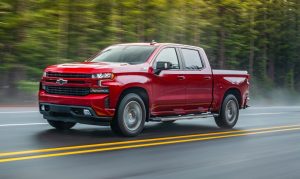
The width of this truck is such that it also takes up most of its lane, without much margin on either side of the painted lines. It needs a green and red lantern to port and starboard.
In its defense, all the current half-tons are like this – because today’s half-tons are dimensionally more like like yesterday’s three-quarter tons.
This is no exaggeration. Check the specs. Today’s mid-sized trucks are the size of yesterday’s half-tons. And today’s half tons are monstrous. Hence the ladders built into their tailgates.
But so long as you’re aware of where you are in relation to where other things are, it’s startling how easy it is to maneuver these leviathans. And how quick they are. Of course, speed isn’t everything in a truck.
Diesel power is about being about to pull – and haul. The Silverado may not be able to drag as much behind it as its rivals, but with its tank topped off, it can go an incredible 600 miles before it has to stop for fuel. That’s farther than a Prius hybrid – and the Prius can’t pull almost 10,000 pounds.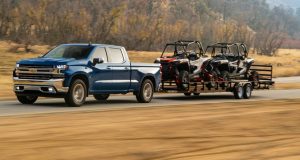
The diesel also makes the right sounds for the situation. There’s a light burble at idle – and an audible whistle as the turbo boost wicks up.
And just like the Big Rigs, the Silverado’s diesel features a Jake Brake; you can use the engine’s compression to slow the truck on downhill runs – with attendant Big Rig sounds.
Rolling coal optional.
Truck buyers are sensitive people. You don’t want to upset them. The current redesign seems to have done just that.
Chevy recently lost its perennial slot as the second-best selling vehicle in the country (after the F-150) to the just-redesigned Ram 1500 – and the only obvious reason for that is the brickfaced, dumpster-emulating front clip Chevy hung on this thing. The grille’s too big; the headlights too small – though they produce plenty of light.
The truck just doesn’t look right.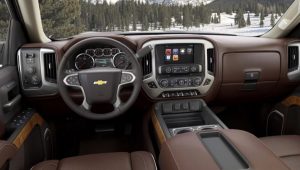
Which is a shame, because the rest of the truck is objectively better. An increase in wheelbase and length increases leg and cargo room (all cab styles) and there’s more cargo volume in the bed than other half-tons, achieved by widening the bed floor by almost seven inches.
If the face of this truck were as handsome as its dash, it’d probably still be number two. Straightforward analog/dial gauges; big air vents, easy to grab knobs and easy to use buttons. The LCD touchscreen is an accessory – not a necessity to operate essential functions.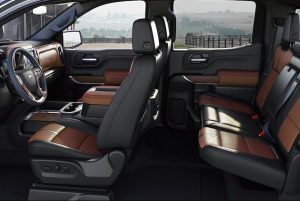
As of this writing, the Silverado is the only half-ton truck that is available with a powered tailgate; you can also get a 120V power point in the bed.
Also, you don’t have to buy the Trail Boss to get the Z71 off-road equipment, including skid plates, locking differential, Rancho off-road shocks and Goodyear Duratec M/S tires. You can add this gear to any trim, even the base work truck.
However, only the Trail Boss gets the factory-installed two-inch lift kit.
The Silverado’s aluminum panels save weight – but add hidden costs. Aluminum is harder to repair than steel and so more expensive to repair.
This will inevitably be reflected in insurance costs, too.
Same issue with the Fiord F-150, incidentally – only more so, because all of its bodywork is aluminum.
The diesel also has to be doused with DEF – Diesel Exhaust Fluid – in order to pass muster with Uncle. This is a small cost, but it’s an annoyance – and it afflicts all the diesels you’re still allowed to buy. Think of Greta Thunberg.
Some good news:
You can avoid the latest driver “assists” if you like. They’re optional – even in the top-of-the-line LTZ and High Country versions of the Silverado.
All trims come with automated stop-start, however.
But there is an Off button.
The Bottom Line
Because the Silverado is currently number three, Chevy dealers will likely be eager for your business.
That means you stand to make a better deal on a new Silverado.
Assuming you can handle that face.
. . .
Got a question about cars, Libertarian politics – or anything else? Click on the “ask Eric” link and send ’em in!
If you like what you’ve found here please consider supporting EPautos.
We depend on you to keep the wheels turning!
Our donate button is here.
If you prefer not to use PayPal, our mailing address is:
EPautos
721 Hummingbird Lane SE
Copper Hill, VA 24079
PS: Get an EPautos magnet (pictured below) in return for a $20 or more one-time donation or a $10 or more monthly recurring donation. (Please be sure to tell us you want a sticker – and also, provide an address, so we know where to mail the thing!)
My latest eBook is also available for your favorite price – free! Click here. 


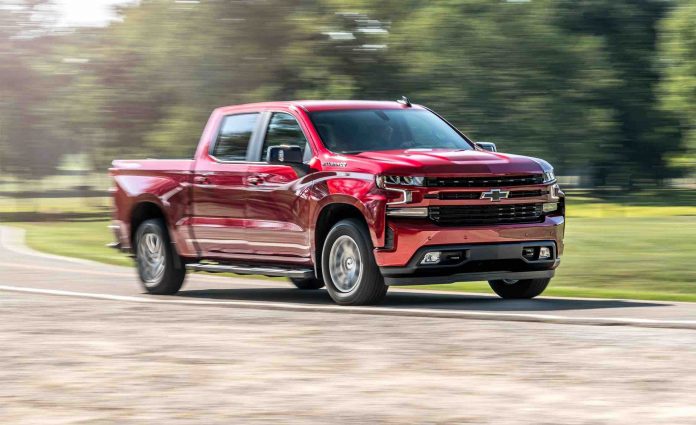

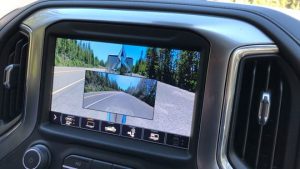

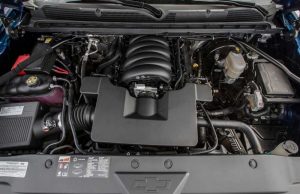
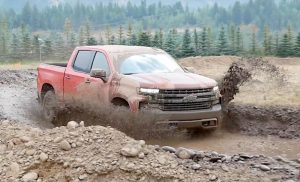
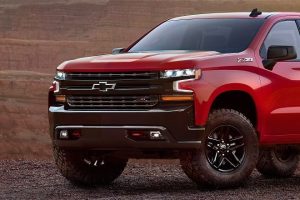
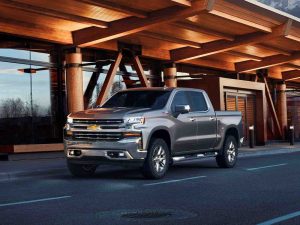








Hey Eric!
Just curious:
Is Chevy E-coating their frames yet?
Do they offer a manual tranny? (Or did I miss mention of it?)
I thought GM had cut you off?
Not that I’m gonna be buying one of these things…. or any new pick’em up…’specially with aluminum bodies!
I can’t even imagine having to shop for any of these modern vehicles, with all cof these “packages” that ya have to mix and match just to get the few important options ya might want (and end up with tons ya don’t want!)- What ever happened to just ordering a vehicle with the options ya want, and nothing more? If I were in the market [shudder], all the minutia I’d have to go through just to figure out how to get what I want, and what it would cost…..and having to deal with “You can’t get this without that, but you can’t get that that with this”, would be such a turn-off, I’d just give up!
WTH’s wrong with these companies?!
“You can’t get this without that, but you can’t get that that with this”, would be such a turn-off, I’d just give up!
WTH’s wrong with these companies?!”
The same reason why auto manufacturers have only 2-3 engines across their entire model lineup: consolidation. It’s just easier (and cheaper) to have 1 or 2 “packages” as opposed to many separate options per vehicle.
Nice, if you want that sort of thing. I’ll stick with my 97 Suburban K2500 (8600# gross package) and my big block. Yeah, it rides like shit and gets crappy mileage (9.8 when I filled it at lunch). It also tows my RV anywhere I ask like it isn’t even back there, and I can carry 8 adults, although I’ll grant you that’s it’s more comfortable with 6. Major lack of nanny accoutrements.
Plus I’m not making payments of a $60k truck that can’t do all that.
Free, I wonder why it rides like shit. My 93 3500 was really smooth but I had some Edelbrock IAS Performer shocks that reacted even faster than the electronic shocks of the time….and later. Of course I had a lot of weight in the bed and 8″ wheels with 265/75/16’s that really helped. Getting ride of the 235/85/16’s was a godsend. But the shocks made it shine. Mine was a Turbo Diesel so the weight should have been close to the same and maybe that Suburban has more rear weight(carrying no load)than the 3500 4WD. The Turbo Diesel got 18mpg. And that’s where the Turbo Diesels shown. Nope, they weren’t anywhere comparable to a Duramax but they would go 600 miles on that 40 gallon tank.
I have a 98 of the same ilk but a 2500 that’s sitting out there getting the batteries charged. I’m going to change the body to my 93 along with the 93 interior and hopefully have what I had before. That old thing with 4.10 gears would pull other pickups out of the mud or sand like nobody’s bidness. It will live again. Stick a Turbo Diesel in it and nearly double that mileage.
Yeah, my junker 1989 K1500 rides pretty good in my opinion, certainly better than our little car and better than the four leaf spring squarebody. As much as I dislike the IFS as a 4×4 it certainly makes for a nice road pickup. As far as I can tell, there isn’t much difference in the basic suspension from 1988 to the present.
I figure the 10-ply Michelin truck tires have something to do with the ride. Air bags in the rear can’t help. It may be time to consider new shocks, although the current ones have no issues as far as I can tell. At least no leaks. Awful hard to bounce test the beast.
If I ever swap the engine, it will be for a big block crate motor. I don’t need to deal with diesel. Nothing against it, but I don’t need the added expense. At 110k this one is tight and uses almost no oil even under the worst tows. I’ve switched every fluid in it to synthetic, so I’m expecting it will last until we’re done with the RV thing in 10 or 20 years.
I’ve got 4 standing offers on it right now, ranging from some folks with horses to my mechanic. I’m thinking of a bumper sticker that says “You can have my truck when you pry my cold dead hands off the steering wheel”.
I gave up on Michelins because of being “hard”. New shocks can make it feel like a new vehicle. I’ve experimented with all sorts of shocks and they are not anywhere the same for the same vehicle. Too bad about the Edelbrock IAS no longer being made since Edelbrock sold that division. I went from Michelin to Toyo’s and there was no comparison. The Toyo’s had much better traction, were very smooth and handled better.
I know how you feel about keeping a good one. I hope to get that 98 body and front clip on my 93 and have it live again.
I just thought our Michelins were hard because they were 20+ years old – lol. I dunno … the tread still looked almost new!
I had one set of brand new Toyos and they were the worst pieces of crap I’ve ever seen. Two ruined with rock breaks within a year or so and the other two wore down very quickly. Maybe they’re fine on pavement ????
My Toyos had to go down back roads with big loads, go to the dump with huge overloads. They has a tread that was nearly cut-proof. Never had a better tire, but then, tires change as they figure out what they can do to make them better. Those Toyos were great on pavement and the worst of roads. The road to my house is chert, real tire killing stuff. They got beat up a bit but never failed. They didn’t suffer as much cutting as other brands.
But Japanese truck tires were always changing(every brand did)and improving. I have some BF Goodrich All Terrain T/A’s now that perform like soft tires bu are holding up on that damned chert. They don’t have to suffer nearly the loads of the Toyos, of which I had two sets. The one ton led a hard life load and road wise. The Toyos had to endure the worst heat year of all times and I commonly drove 90 mph even with heavy loads.
I’m sure every tire brand goes through countless changes year after year. Everybody bragged about their Cooper’s but they were rough and made enough noise you wanted them to wear out.
Toyos had a great reputation for a while but then must have gone to hell. Otherwise I wouldn’t have paid about 1.5x what other tires cost just so I could have something that wouldn’t go flat and blow out all the time, or so I thought. This was back about 2006 or so I think. Only had them a couple years or so, along with the two that I had to buy used to replace the ruined Toyos. Then one of the factory alloy wheels cracked and I got a set of junkyard steel rallies and 4 new Kumhos which are still on the burban with almost new tread but legally are probably “too old” now.
Or maybe the 15″ C range Toyos are just crap ????
I bought a set of Kumhos for the car and they were fine until it gets down below 20*F when they had no traction whatsoever. Apparently that size in that brand only come in some sort of racing type tire. So I finally got sick of that and found some 15″ junkyard rims and some tires with sidewalls that don’t quite beat you to death and actually have some traction. Saved $200 on the tires and spent $100 on the wheels.
This is the second set of Michelins on the truck since we bought it in 2001. Not kidding. It’s driven maybe 3k per year and garage kept when not in use. First set I actually managed to wear out the tires without them dry rotting. Hoping for the same on this set. If they last as long as the first set, they’ll last me the rest of my RVing time.
Interesting tire info, though. My 01 GMC Sierra is going to need new tires soon. I drive it maybe 8k per year and it has to sit outside in the weather. If I go with 10-plys on it, Michelins will dry rot before I can wear them out. I want a street tread, since its a 2WD. No clue what I’ll put on it. Maybe I’ll just stick with the Michelins.
Our 30 year old jeep had Michelins on it when we bought it about 4 years ago. I’m pretty sure they were the first replacement tires because the spare appeared to be factory. Had to replace them earlier this year because the shop wouldn’t fix flats on them anymore. He claimed they were 12 years old but I’m pretty sure he was wrong: my guess is they were 22 years old!
The new tires sure ride a lot smoother. Those old Michelins rode like steel tractor wheels.
On a vehicle not driven much you might as well buy the cheapest new tires you can find.
I would totally buy a full sized pick up like this or the F150 for protection on the road from idiot clover drivers in our town of not-safe, unaware certain un-named minorities and senior drivers and to piss off my neighbors so I can smash their stupid green plastic safety-man barriers they put in the middle of the road so their entitled children can play out in the street thus usurping my tax payer right to the street I partially own… but I go downtown a lot and need a truck that will fit in the low over-head clearance garages, some as low as 6′-0″ !!!! Any suggestions for a truck ?
“Diesel fuel also costs about 30 cents more per gallon than regular unleaded – also because of regulatory compliance costs.” Although much is affected by regulatory fiat, ultra-low sulfur diesel (ULSD) was supposed to only cost a few cents more per gallon than low sulfur diesel which enjoyed a cost advantage over regular gasoline.
What makes the current diesel more expensive is that now refiners in the US are allowed to export it and the world desires ULSD making it more expensive here due to demand. Gasoline continues its place as a result of refining techniques to be a waste product of diesel production and thus cheaper to buy per gallon if still more expensive to use due to poor fuel economy.
Hi Peter,
ULSD was “supposed” to cost “only a few cents more.” And you can keep your doctor, if you like.
Etc.
The bottom line is that Uncle’s to blame for the uptick in the price of both diesel and gasoline. Were it not for the ethanol mandate, gas would probably cost at least 20 cents less and contain more energy per gallon; diesel would cost even less than gas, too.
Both European and US transport Economy’s run on diesel, therefore the price of fuel is dictated by the market for diesel. There’s a quote in gasoline production when everyone was diesel for their industrial and trucking needs as well as cars in Europe. This makes gasoline relatively cheap compared to diesel on the open market.
My comment is supposed say there is a glut in gasoline production when the demand is for diesel since distilling crude oil usually requires making both. Cheers.
Hi Peter,
Yes, but both the European and U.S. transport economy also ran on diesel in the ’80s… and diesel was much cheaper than gasoline then.
Short memories fellas. In the latter part of ’08 both fuels costs soared. It was the Shrub’s way of giving back to big oil.
The day the cheapest diesel I could find “for cash” was $5.26/gal, it was obvious what was going on. A few months later both fuels dropped over a dollar a gallon after BO got into office, probably the only good thing he ever did…..calling off the dogs. It wasn’t bad enough that the economy had tanked but then fuel prices went off the charts. It was a payout for WallStreet. As industry spokesmen finally justified the increase as letting the price be set by “futures”.
I enjoyed working in the patch but had no illusions. This last go round you could diss big oil and govt. and have agreement. In the 60’s you didn’t dare open your mouth about such.
MY science teacher and another student and I distilled petroleum and made the various components. It’s the light oils that come off first and are the bulk of the whole process. Kerosene is just No. 1 fuel but I recall paying fifteen cents a gallon for it in 1970 and used it to clean parts. A few years later it was sold in truck stops as #1 fuel and was a couple cents higher than #2(common diesel).
I could never understand why it was so hard to find in Texas but almost always an option at the pumps in other states. It was like a tune-up in your tank and the old diesel seemed to smile using it.
When I was in Mexico in 04, my cousin and ex-trucker also, said something about always smelling kerosene. It was #1 fuel that you bought in Mexico. My pickup liked it and had that kerosene smell to the exhaust.
Back in the 80’s when Reagan got the WH, fuel went out of sight again as did electricity and all things petroleum based, even butane. People were buying kerosene heaters to cut down on heating bills. It didn’t take long at all for it to go to $3/gal. Well, chunk the kerosene heater and try to pay the electric or propane bill. In fact it went from being bought bulk to having them put it in one gallon steel cans. It was long before that I forgot about the kerosene heater and cut a Lot of wood.
Eric, it was only after the US allowed oil companies to export the finished product that ULSD became available on the world market where prices were higher than in this country.
If you heat with oil, depending on where you live, on road diesel and #2 heating oil are the same except for the dye. Pretty much every New England state requires heating oil to be ulsd, and it simplifies supply chains. That’s a not insignificant difference in price, and the odds of a Statie dipping the tank of a 1/2 ton or tdi are pretty slim.
Under the circumstances you drive, I would never use anything but Class E tires. There’s just no comparison to Class C.
I had never considered you using a lesser tire. I used Class E on everything, 1/2 ton and even tiny japanese pickups. That chert don’t care what’s passing over it. I’ve blown really big implement tires rolling over that chert and had 42″ tractor tires going along spewing water from RR spikes. A 3/4Ton vehicle needs Class E if you intend to do anything but run on pavement with no trailer.
You said you had a 2500. A class C is a joke to that size and weight vehicle. Not giving you hell, just sayin. I never even considered anything less than Class E on a 3/4 T so I have no experience with Class C tires. My 76 heavy half has BF Goodrich Class E’s on it. Roots, limbs, mesquite thorns and rocks will do in anything less.
Sewing machine quiet and ass-butt ugly.
A point of correction: apparently, the current 4.3L V6 is not the same design is the previous 4.3L V6. The previous was effectively a 350 missing a couple of cylinders, while the current one is derived from one of GM’s newer small-block V8s.
Saw a mid 90’s Silverado driving next to a new one. The size difference is very startling. Granted the 90’s was 2 wheel drive vs the new ones 4 wheel drive. But the new one is so much larger.
Hi Rich,
Cueing my best OJ voice… I don’t like these new trucks…they’re absurdly cod-pieced, cartoonish things. When a 6 ft 3 man needs to stand on a milk crate to get at things in the bed, things have gotten out of hand…
Agree. It started happening about 5-10 years ago and one of the reasons I kept with GM longer than I wanted to because they had the lowest bed reach in, and the lowest tailgate height. It mattered to me because I mostly use a truck to carry dirtbikes and me being a short guy, tailgate height was an issue in loading dirtbikes. Same issue with step in height. GM is now equal to the rest.
All the new fancy tailgate steps has not helped in loading dirtbikes BTW, the angles are all wrong trying to push up a 230lb bike.
I got a ford f150 recently and took it to a local mechanic who lowered the rear of the truck easily for me by just removing some riser blocks. ahhhh, better.
Hi Chris,
I was talking with a friend the other day about all this. I have a theory: All this hyper-macho stuff – it’s not just trucks, look at the angry Samurai faces of almost every new car – is a reaction to the fear and frustration and sense of powerlessness that many people (reasonably) are feeling. They are worried about money, worried something they say will cost them their job, micromanaged and nannied and pestered and possibly Hut! Hut! Hutted! at every turn… so they get a car (or truck) that compensates for all of that – even though, of course, they can’t use the thing for much without risking all the consequences that have made them so enervated.
On a more practical note, high sides and beds help with aerodynamics and increase the carrying capacity number. Even though cubic inches don’t translate to practical use capacity it makes a side by side comparison come out in front of the competition. Same thing with ground clearance. The few people who care about such things (mostly list-the-numbers reviewers) made ground clearance an important talking point in the 1990s so that’s what got the attention.
Truck buyers (or at least dealerships) still care about numbers, so numbers is what they get. Even if the numbers are beyond meaning.
Hi RK,
Yup. So we get gigantism instead of usefulness. I parked one of the new behemoths next to a circa ’89 regular cab Chevy 1500. The new truck dwarfed the old one. The bed walls of the old truck were about the height of my chest; I could easily look into the bed and reach things in the bed without standing on my toes. Getting in and out of the cab was much easier; no need to grab a rail and pull yourself on board.
eric, my 93 has as much clearance as a new pickup but it’s easy for ingress and egress and you can reach into the bed. I just sold a pickup, an 82 3/4T Chevy 4WD. It was like riding in a sports car.
The styling didn’t make you cry out in the night if the running lights were left on.
I still say, the 89-2000 GM pickups were the nicest looking pickup every. Smooth lines….and smooth lines. They have so much more room inside in the early models that the later airbag models it’s not funny. Mine has captain’s chairs in the front but room for four in the back seat. I wouldn’t mind the 3 across front if they had armrests both sides. For me and my meters and other such tools you’d rather not have in a tool box was a boon for that huge console….but if the top flipped up for a seat back and a cushion were underneath I could live with it. Then again, you lose a buttload of storage with that type of console. Not much to bitch about in the front of the 98 except there are no hidey holes on the sides with airbags there instead.
Some designs, all of which we have our own tastes, are classics. I think that of the early 90’s GM trucks. They tried so hard to regain market share from losing to Ford due to little engines on their half tons in the 80’s they outdid themselves.
I compare them to a 4020 John Deere. They didn’t mean them to last that long.
When I go to a larger town and shop, I see countless 90’s model GM pickups. I almost never see 90’s Ford pickups and very few Dodge’s since Dodge had a better idea, use shit for the inside instead of quality “plastic”.
Every handle on my Z71 that was steel on the early 90’s pickups is plastic. Everybody with one has a list of how many endgate handles they’ve had and the little turd plastic holders inside for the steel rods. Just a plain old thin stamped steel holder did a great job and you never had to replace them(well, not in non-salted road country). Seats and windows were better and so were the steel endgate holders compared to squiggly plastic covered twisted wire.
BTW, the 82’s bed was galvanized.
I walked by a new Chevy truck a couple days ago. I’m 5’11” and the bed was about shoulder high. This and the fact that I can’t afford one are my gripes.
Hi Bin,
Trucks, like cars, reached the apogee of their development about 25 years ago. A late ’80s/early ’90s Chevy 1500 with a TBI-injected small block V8 and a five-speed manual was capable of almost 30 on the highway, had an agreeable ride, a nice cabin that could be ordered with the necessaries such as AC, power windows and a good radio. Simple/rugged manual-lever 4WD. The bed was accessible and so more usable than a modern truck’s bed.
Everything since has been an attempt to gild the lily – and add to its price.
eric, there’s a lot of those still in this country and some look like they just rolled off the showroom floor. I was kidding this young guy about buying his when we were at the pumps side by side. H was pulling a big RV and I said he should sell it to me. He just grinned. It was white and righteous. I’d not hesitate to travel around the world in one. R 12 freon, big radiators and independent 4WD front and like you say, levers to control that system, no damned buttons.
My old one ton would hunker down in low range and literally drag a big pickup out of the sand or mud. Those big Toyo’s were great tires(had two sets) and two sets of AGM batteries that lasted 8 years each. Quiet as hell on the inside and when you pulled the pockets out in the back seat the inside of the sheetmetal had some thick stuff like trunks used to have. I kept lots of soft parts in those compartments and plenty of stuff in the console and under the seats. I use big truck mud flaps and cut them to fit the floorboards. Anything that’s spilled goes right to the door. Nice interiors and good stereos. Electric door locks and windows, nothing ever went wrong on them. I liked the rear windown that popped out at the rear when the weather was nice and the air just came through very nicely. It was a way to keep the dog in the back seat cool just sitting somewhere.
I had one dog that wouldn’t let anyone close to it. It was blacked out and you couldn’t see him but he could see you. He’d seen people that got too close packing in a hurry. The carpet wasn’t that bs cut pile either. It was loop pile and lasted forever and looked great. The only way it could have been better was to have a galvanized bed like the 82 had. Just sold that truck a couple weeks ago. The guy’s making a truck for his soon to have a DL daughter. She’s hot for it and it’ll do her fine. It was one of those rare 4 shock front ends that just flew over rough stuff without a wiggle or anything negative.
Eric, here are some measurements I just took from my full size ’71 C-10 with factory ride height. These are from ground level to top;
Bed sides, 45-1/2″
Top of Rocker panels, 16″
Tailgate when down, 26″
Top of cab, 69″
To me these are perfect. Easy to get in and out of the cab, easy to reach over the sides into the bed, and easy to load cargo from the rear.
Ground clearance is nice but it isn’t exactly getting any better.
The first/best thing for ground clearance is tires and the builders insist on putting on /65 tires or flatter while most pickups have fender room for a 35″ tire, at least in height. And the front approach angle is as bad or worse than most cars with all the dang plastic sticking out and hanging down.
My “old” 73 K-20 with 7.50-16 tires could crawl over just about anything yet it wasn’t that big or tall compared to what they’re making now.
So the newer pickups are getting taller and lower to the ground at the same time.
That K 20 was 15′ long. A new crewcab long bed is 30’…or a bit more.
Right about 18′ to be exact, because that is what my 1976 C-20 measures. The rare crew cab from back in those days would be quite a bit longer but the same width unless it was a dually.
Point is that a regular cab long bed C/K 10, 20, 30 (with single rears) would all be the same length/width on the sheet metal, while the frame, axles, etc etc etc would be a lot different.
Same thing is true today as far as I know although they’ve come up with all these weird short bed sizes. So a 1500 is the same width as a 3500 HD SRW.
I don’t recall GM making anything shorter than a 6.5′ bed and that’s too damned short.
The ultimate useless truck was the Ford with a 5′ bed. Back when oil companies and support companies were getting 0% interest, they would buy a new fleet of pickups. The expensive Platinum job always had a 5′ bed. So they’d put an in the bed tool box and a cooler behind that and the bed was full. What a joke.
Now those short beds are commonly covered and sealed. What you have is a big car with a large trunk. The public has spoken and since you can no longer buy a big car, buy a pickup. Makes sense to me. The entire family has a seat just like the old days(ok, they’re not that wide inside….and maybe outside too)and a separate trunk with a locked endgate.
I sometimes wonder how quickly a Vista Cruiser could dominate the market if they could be sold.
For sure they do because my neighbor has a 2015 1500 with maybe a 4.5′ or 5′ bed. You can barely fit a post hole digger in there diagonally. Then he bought a new Sierra 2500 HD and I don’t think its bed is even 6.5′ (maybe 6′ ???).
Until the fairly recent madness the GM beds were either 6.5′ or 8′ with the exception of the “longhorn” from back around 1970 that didn’t catch on.
Anon, read this and eat your words carefully. Only one year they ever made and extra short bed.
Uh, I forgot this.
http://dicksautoparts.com/c-1128487-truck-beds-chevrolet-gmc-truck-beds-14-15-chevy-silverado-gmc-sierra-truck-beds.html
This thing could pass as a new Tundra. Very Japanese-esque.
The safety regs have destroyed the human scale. I’m about 6’3″ in sneakers, and I feel small and powerless around these things. That’s exactly what totalitarian design is about – to make the individual feel powerless.
If I pull next to a new pickup in my full size ’71 C-10 it looks like a child’s toy size wise.
Speaking of Frau Greta …
Check the video before all of these clips disappear. Same delivery/cadence.
https://www.youtube.com/watch?v=FMoxZeTeRPE
Laura Ingraham was right.
“half-tons are dimensionally more like like yesterday’s three-quarter tons.”
NO! The current half and 3/4 tons are dimensionally more like the medium duty C-50 or C-60 of the 1960s-1980s!
There really has never been any difference in size between 1/2 and 3/4 ton now or then except for the ride height and tire size. Same for a one ton except there you start getting into dual wheel and longer frame options.
I wish to hell that people that want to pull 40,000 pound trailers would have just bought medium duty trucks for the job instead of goading the Big Three into upsizing everything. Back in the 1980s I had a real truck for hauling logs, not a pickup.
dread, you couldn’t possibly be any more wrong. 3/4T have floating rear ends, a great deal better and larger gears, larger driveshafts, larger coolers, larger brakes, larger frames, and larger everything to do with suspension than a half ton. Their engines are made more for pulling and the transmissions are stronger as it the entire driveline. Their coolers are larger and all steering parts are larger.
A one ton is much larger in the driveline and cooling and brakes dept too than a 3/4. I’ve owned everything from 1/2, Heavy Halfs, 3/4 T and one tons. The one ton has a much larger frame than a 3/4 and same goes for the difference between a half and 3/4.
I prefer one tons for many reasons, and brakes are a good place to start. Well, everything is heavier and takes more abuse on a one ton or nobody would buy one.
. You can’t legal 20 tons with a one ton and the DOT will let you know quickly enough in Texas. I see one ton’s with huge trailers stopped more than big rigs. You can get an overweight permit in Texas for big rigs but that extra 4000 lbs will get you a ticket on the interstate even with the permit. I can tell the difference in the size of a rear-end on a one ton and 3/4 just by looking.
Of course they are bigger inside and underneath, but the sheet metal and footprint is the same, except for some variations in wheelbase.
You can take a half ton cab and front clip and bolt it right onto a one ton, or vice versa. Of course these days the dang electronics probably won’t plug in because of different engines/transmissions/processors.
You’re mighty wrong about that now. The cabs are model specific and the front clips are certainly model specific. The tracks are not the same for certain. You’re certainly correct about the electronics. Even my 93 has a different wiring harness from the 98 I bought….and I get to remove both to get the one I need plus the interior. My single wheel one ton won’t follow in the same tracks as a 1/2 ton. Axle width and spindles are all totally different and the frames are as different as they can be.
“Dumpster Face…….”
I’m not a chevvy fan, but the Silverado’s mug doesn’t look any worse, or better, than the grotesque fronts of any of the other current generation of full sized trucks.
Two thoughts Eric.
“You couldn’t do that with a FWD K-car sportin a 2.4 liter “Hemi” mounted sideways up front.”
It was a 2.6L (Mitsubishi Astron) Hemi vice 2.4L. in Ye Olde Kay-Karr
Second, GM does not appear to me to have the engineering chops anymore to design a Diesel. They gave away Opel and Vauxhaul, and Detroit (Driptroit) Diesel too…so, is this an indigenous GM Diesel, or an Isuzu, or something else? Curious about that one.
A Duramax is 900 lb ft of torque and the new design is going to be nearly indestructible. I learned this not from an ad or a GM lover but from Gale Banks showing all the differences of the parts inside one plus they have a single belt just to drive a huge fan so no over-heating, one of the failings of the electric fan club.
I only know 1 person who dropped the bottom end on a Duramax and he had it chipped and over-revved it by a lot. It wasn’t the fault of the engine and he said so.
Oh yeah, the V8 Diesels, they’ve got them singing. GM done good with them.
I was wondering about new design capability, since GM’s not recently done a Diesel Six. It turns out, this is an INLINE SIX! Wow, if it holds up like the V8 Duramax, they really have something there. DOHC, LP EGR, the only thing I can see that might kill durability is the cam drive…it’s a back-of-the-engine relay chain drive (like the VW 2.5L Five), with the fuel pump in the middle carrying the “relay” sprockets. VW went through some teething pains on that cam drive setup on the Five. Gear drive up front would have made it indestructable, as it is, we’ll see. I’m pulling for them on this one, I have a soft spot for inline sixes.